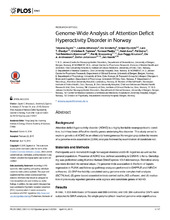| dc.description.abstract | Background Attention deficit hyperactivity disorder (ADHD) is a highly heritable neuropsychiatric condition, but it has been difficult to identify genes underlying this disorder. This study aimed to explore genetics of ADHD in an ethnically homogeneous Norwegian population by means of a genome-wide association (GWA) analysis followed by examination of candidate loci. Materials and Methods Participants were recruited through Norwegian medical and birth registries as well as the general population. Presence of ADHD was defined according to DSM-IV criteria. Genotyping was performed using Illumina Human OmniExpress-12v1 microarrays. Statistical analyses were divided into several steps: (1) genome-wide association in the form of logistic regression in PLINK and follow-up pathway analyses performed in DAPPLE and INRICH softwares, (2) SNP-heritability calculated using genome-wide complex trait analysis (GCTA) tool, (3) gene-based association tests carried out in JAG software, and (4) evaluation of previously reported genome-wide signals and candidate genes of ADHD. Results In total, 1.358 individuals (478 cases and 880 controls) and 598.384 autosomal SNPs were subjected to GWA analysis. No single polymorphism reached genome-wide significance. The strongest signal was observed at rs9949006 in the ENSG00000263745 gene (OR=1.51, 95% CI 1.28–1.79, p=1.38E-06). Pathway analyses of the top SNPs implicated genes involved in the regulation of gene expression, cell adhesion and inflammation. Among previously identified ADHD candidate genes, prominent association signals were observed for SLC9A9 (rs1393072, OR=1.46, 95% CI = 1.21–1.77, p=9.95E-05) and TPH2 (rs17110690, OR = 1.38, 95% CI = 1.14–1.66, p=8.31E-04). Conclusion This study confirms the complexity and heterogeneity of ADHD etiology. Taken together with previous findings, our results point to a spectrum of biological mechanisms underlying the symptoms of ADHD, providing targets for further genetic exploration of this complex disorder. | en_US |

